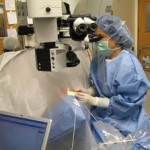Glaucoma is a group of eye disease wherein the optic nerve is damage which may cause loss of vision. The abnormal high pressure inside the eye or called intraocular pressure is the frequently reason behind this damage but not at all times. Early glaucoma treatment can help to lessen or even prevent the possible damage to the optic nerve.
Glaucoma is considered as the second leading causing blindness. It is sometimes known as the silent thief of sight. Glaucoma can damage the eye vision slowly without becoming aware of any loss of vision until the disease had reached an advanced stage. The most frequent type of glaucoma is the primary open-angle glaucoma which does not manifest any signs or symptoms except for slowly loss of vision.
It is very essential to have an eyes check-up regularly and let your eye doctor measures your intraocular pressure.
What are the signs and symptoms of glaucoma?
Primary open-angle glaucoma and acute angle-closure glaucoma are the most frequently types of glaucoma. They have entirely different symptoms.
Signs and symptoms of primary open-angle glaucoma are the following.
- Loss of peripheral vision slowly typically in both eyes
- In advanced stages, tunnel vision occur
Signs and symptoms of acute angle-closure glaucoma are the following.
- Extreme eye pain
- Nausea and vomiting with severe eye pain
- Unexpected onset of visual disturbance frequently in low light
- Blurred or unclear vision
- Halos around lights
- Reddening of the eye
What are the causes of glaucoma?
Increased pressure inside the eye that normally connected with the optic nerve damage that may characterizes glaucoma. The reason behind this is not yet fully understands by the doctors. The pressure occurs from a buildup of aqueous humor, a fluid that naturally and constantly formed in the front of the eye. This aqueous humor generally exits the eye all the way through a drainage system at the angle where the iris and cornea meet. Once the drainage system does not work appropriately, the aqueous humor cannot sort out of the eye at its regular rate building pressure inside the eye.
What is the risk factors affecting glaucoma?
Vision can be destroyed by the chronic forms of glaucoma prior to any signs and symptoms become noticeable. So, you should be aware of the following factors.
- There is a greater risk of having glaucoma if the intraocular pressure is higher than normal, despite the fact that not every person with high intraocular pressure develops the disease.
- People with an age of more than 60 have a greater risk of developing glaucoma. But there are certain population groups like the African-Americans that have an increased risk of having glaucoma even at a younger age.
- Racial background like the African-Americans is five times more prone to have glaucoma than the Caucasians and have more possible to have a stable blindness as its effect. Asian-Americans and Mexican-Americans have also greater risk of developing glaucoma.
- If glaucoma runs in the family, you have much bigger possibility of having it. Since, glaucoma may have connection with the genetics.
- Severe eye injuries can have an elevated eye pressure. Injury can also displace the lens causing the closure of the drainage angle. Eye tumors, eye inflammations and retinal detachment are can also increases the risk of developing glaucoma.
- Nearsightedness wherein the objects in the distance look unclear with no glasses or contacts have greater possibility of developing glaucoma.
- Making use of corticosteroid for extended period of time may place you at threat of having secondary glaucoma. This is true particularly of using corticosteroids eye drops.
Â
What is the glaucoma treatment?
Glaucoma treatment decreases the intraocular pressure by making the aqueous outflow gets better, lessening the production of the aqueous, or both. Glaucoma treatment cannot be completely healed the glaucoma or even reversed the damage caused by the disease. However, this glaucoma treatment and regular eye checkups can avoid the loss of vision in people affected with an early glaucoma. If in case, the visual loss has already arises, glaucoma treatment can slow or can avoid more loss of vision.
1.    Medicated eye drops.
 Glaucoma treatment frequently begins with the use of medicated eye drops. Just make sure to use the eye drops accurately as advised by the doctor because if not, the damage in the optic nerve may possibly get worse. If the health care provider prescribe more than one kind of eye drop, inquire of how long to wait between each applications. The most commonly types of prescribed eye drops are the prostaglandin-like compounds which includes latanprost and bimatoprost, beta blockers like timolol, betaxolol and metipranolol, alpha-agonists like apraclonidine and brimonidine, carbonic anhydrase inhibitors like the dorzolamide and brinzolamide, cholinergic agents like pilocarpine and carbachol and epinephrine compounds like dipivefrin.
Glaucoma treatment frequently begins with the use of medicated eye drops. Just make sure to use the eye drops accurately as advised by the doctor because if not, the damage in the optic nerve may possibly get worse. If the health care provider prescribe more than one kind of eye drop, inquire of how long to wait between each applications. The most commonly types of prescribed eye drops are the prostaglandin-like compounds which includes latanprost and bimatoprost, beta blockers like timolol, betaxolol and metipranolol, alpha-agonists like apraclonidine and brimonidine, carbonic anhydrase inhibitors like the dorzolamide and brinzolamide, cholinergic agents like pilocarpine and carbachol and epinephrine compounds like dipivefrin.
2.    Oral medications.
 Doctor may also prescribe an oral medication if in case medicated eye drops don’t get the eye pressure down to the preferred level. Carbonic anhydrase inhibitor is the frequently oral medication that prescribed by the doctor. This should be taken with meals to lessen side effects.
Doctor may also prescribe an oral medication if in case medicated eye drops don’t get the eye pressure down to the preferred level. Carbonic anhydrase inhibitor is the frequently oral medication that prescribed by the doctor. This should be taken with meals to lessen side effects.
3.    Surgical procedure.
 Surgical procedure can be considered as glaucoma treatment if any medications are not already effective in attaining the purpose. At times, single surgical procedure may not be enough in lowering the eye pressure. Using of eye drops after surgery or have another operation if still needed. Surgical procedures that used as glaucoma treatment are the laser surgery, filtering surgery and drainage implant surgery.
Surgical procedure can be considered as glaucoma treatment if any medications are not already effective in attaining the purpose. At times, single surgical procedure may not be enough in lowering the eye pressure. Using of eye drops after surgery or have another operation if still needed. Surgical procedures that used as glaucoma treatment are the laser surgery, filtering surgery and drainage implant surgery.
Regular eye examination is the key in discovering early stages of glaucoma and to make sure of attaining a successful preventive glaucoma treatment.
